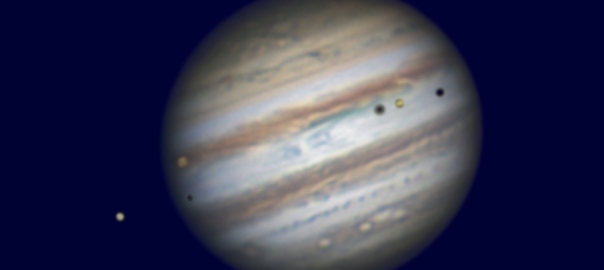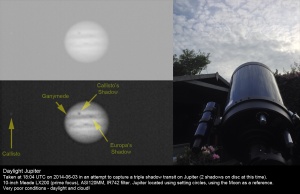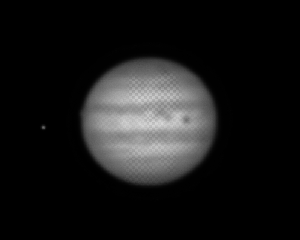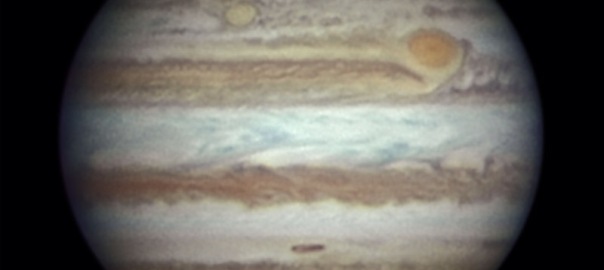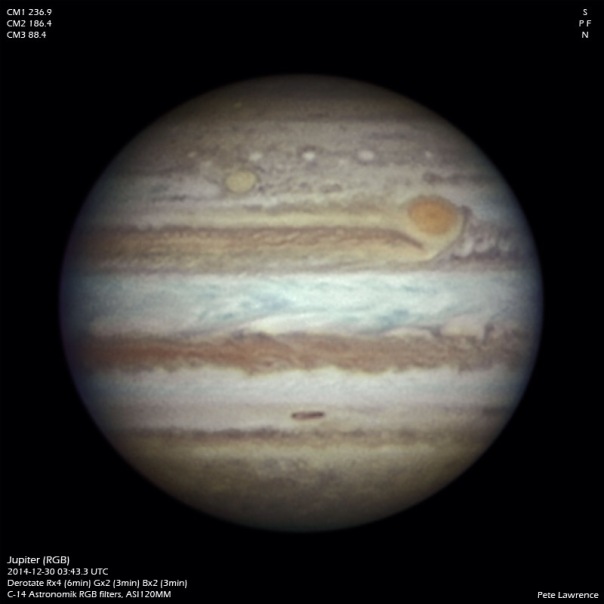I returned from an exhausting set of Northern Lights flights on the afternoon of 23 Jan 2015. An early night followed both because I was so tired and also because the weather forecast was favourable for the early hours of 24 Jan. Between 06:23 and 06:58 the planet Jupiter would be crossed by no less than 3 dark moon shadows, cast by the Galilean moons Io, Europa and Callisto. This is an event I’d been looking forward to for some time and had promoted via my writings in the Sky at Night Magazine and also the Star Guide I present on the Sky at Night TV show. Here’s the simulated view at 06:40 UT I created…
The reason for pushing the event is that this was the last opportunity to see a triple shadow transit until 2032. Such events tend to come in small bursts with up to 3 triple shadow transits occurring within a relatively compact timescale. This batch started with a triple shadow transit which occurred on the morning of 12 October 2013, one for which I was clouded out! The next one occurred when the Sun was still up on 3 June 2014. That one I managed to observe and image through ever thickening cloud despite the bright sky. Consequently the images weren’t amazing but at least I got it! It took a lot of patience though.
The final triple shadow transit on 24 January 2015 should have been much better but as it turned out it too was rather tricky to view and image. For me the first problem I had was due to fatigue from the Northern Lights flights. I was so tired that I had my doubts as to whether I would actually be able to get up. I set a wake up alarm on my old trusty Blackberry Torch 9800 (I’ve found my iPhone 5’s alarm function to be unreliable and I don’t trust it anymore!) for 04:00 on the 24th and went to bed at 22:00. Before going to bed, my weather apps indicated that rain would pass through the area before the sky cleared. I put my C-14 outside but under cover of my observing cabin’s porch.
Amazingly, I managed to wake up quite naturally at 03:50, before the alarm sounded (how does that happen?!) and headed downstairs. I needed to move the mount for my C-14 across to the east boundary of my garden so I could see the transit which occurred at low altitude in the west. Unfortunately, this meant setting up on a wet lawn. The resulting mud bath at the end of the session was quite impressive! When I went to collect the C-14 from its sheltered location – now properly cooled to match the outside air – I discovered that the rain that fell must have come in sideways across the porch because the scope was wet through.
A quick check inside showed that the main mirror was about 50% dewed up. So I mounted the scope and made the executive decision to remove the corrector plate so I could dry the mirror with a hair dryer. This shows why it’s a good idea to give yourself plenty of time to prepare for events such as this. Of course, the hair drying exercise destabilised the internal temperature of the telescope but there was still time for it to cool properly.
When I finally got a view of Jupiter it was clear that the seeing was pretty awful – some of the worst I’d seen to be honest. Click here to see a video of just how bad it was! The reason for this was mostly down to a raging northerly jet stream.
I decided to image at prime focus with my ASI 120MM mono high frame rate camera. This still allowed me to see detail but removed some of the nastiness that the poor seeing was pouring down my scope. To make matters worse, the event was due to occur in a location that would position Jupiter above the central heating vent of a neighbour’s house. No matter where I went in my garden, the vent remained in a problem position. It reminded me of a portrait in oils and the way the eyes appear to follow you around the room!
The end result was less than impressive compared to what the C-14 is capable of with this fantastic planet. However, there was a feeling of satisfaction that I’d made the effort and overcome a few unexpected hurdles. In the end, I figured the best way to present the results was to add the 60 separate images I took through a 742nm IR filter (this helps stabilise bad seeing – but there’s a limit!) and animate them together. Here’s the result (click on the animation to load a larger version)…
What you’re seeing here are the dark shadows of Io and Callisto off to the right. Look carefully and you might be able to see Io as a slightly brighter dot moving from Callisto’s shadow (the left hand one of the pair). These are joined by two further dark dots on the left of the disc. The upper one is the moon Callisto transiting across Jupiter’s disc – a fairly rare sight in itself. The lower dark spot is the shadow of Europa. The moon Europa can be seen off to the left of Jupiter.
